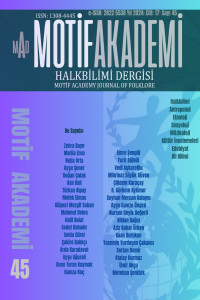Öz
ABSTRACT: Çıkrık Village is located in the central district of Çorum. Çıkrık Mosque is located in the village center. There is no construction inscription of the mosque. The document regarding the appointment of the imam dated 1843 in the foundation records archive shows that the mosque existed in the first half of the 19th century. The date 1904 is read on the sign on the entrance door of the mosque. This date must belong to a radical repair that the mosque underwent. The repairs carried out in the mosque are aimed at the functionality of the mosque. When you enter the harim, it becomes clear that the mosque attaches importance to aesthetic values as well as functionality. The hand-drawn embroidery in the harim, consisting of floral motifs and text dominated by turquoise color, is of recent date. These embroideries are important because they show the transformation of the tradition of an era into the character of a region, rather than artistic creation. The aim of this study is to examine the tradition of hand-drawn embroidery, which has been decorating mosques in Çorum for centuries, in the context of Çıkrık Mosque. In the study, first of all, the architectural and ornamental features of Çıkrık Mosque were introduced and documented. Then, Çorum was included because it is the keystone of the tradition that spread from the city center to the districts and villages. Çıkrık Village was a village affiliated with Mecitözü until the 1990s. For this reason, the mosques identified in Mecitözü and its villages are included in this study. It is possible to say that decorating mosques with hand-drawn embroideries in the mentioned regions has been seen as a period style since the 18th century, and today it has turned into a cultural practice with a traditional aesthetic understanding.
Anahtar Kelimeler
Mecitözü Çıkrık Village Mosque hand-drawn work embroidery decoration
Kaynakça
- Çerkez, M. (2019). Mecitözü’nde mütevazı bir külliye: Alören köyü külliyesi. History Studies, 11(2), 495-533.
- Demiryürek, M.- Ozulu, A. (2017). Eşref Ertekin’in Günlüklerinden Bir Zamanlar Çorum. Çorum: Çorum Belediyesi Kültür Yayınları.
- Dündar, A. (2004). Çorum cami ve mescitleri. Ankara: Motif Yayınları.
- Ekici, M. (2008). Geleneksel Kültürü Güncellemek Üzerine Bir Değerlendirme. Millî Folklor, 2008, Yıl 20, Sayı 80, 33-38.
- Ilıca, A. (2006). Çorum Ulu Camii ve Vakıfları. Ankara: Matsa Basımevi.
- Karaçay, Ç. (2021). Gelenekçi Duvar Resminde Kültürel Kodların Çözümlenmesi: Doğla Camii Örneği. Hitit İlahiyat Dergisi, Cilt: 20, Sayı: 2, 589-622.
- Karamağaralı, H. (1965). Çorum Ulu Camiindeki Minber. Sanat Tarihi Yıllığı. S 1, 120-142. Semavi, E. Çorum’un Mecitözü’nde Aşık Paşa-oğlu Elvan Çelebi Zâviyesi, Türkiyat Mecmuası 15 (1968), 211-244.
Öz
ÖZ: Çıkrık Köyü günümüzde Çorum’un merkez ilçesine bağlıdır. Çıkrık Camii köy merkezinde yer almaktadır. Caminin inşa kitabesi bulunmamaktadır. Vakıf kayıtları arşivinde 1843 tarihli hatip ve imam atamasına dair belge caminin 19. yüzyılın ilk yarısında mevcudiyetini göstermektedir. Caminin giriş kapısı üzerinde yer alan tabelada 1904 tarihi okunmaktadır. Bu tarih caminin geçirdiği köklü bir onarıma ait olmalıdır. Camide gerçekleştirilen onarımlar caminin işlevselliğine yöneliktir. Camide işlevselliğe olduğu kadar estetik değerlere de önem verildiği harim mekânına girildiğinde anlaşılmaktadır. Harimde turkuaz rengin hâkim olduğu bitkisel motifler ve yazıdan müteşekkil kalem işi nakışlar yeni tarihlidir. Bu nakışlar sanatsal yaratımdan ziyade bir devrin geleneğinin bir bölge karakterine dönüşünü göstermesi açısından önemlidir. Bu çalışmanın amacı Çorum’da yüzyıllardır camileri süsleyen kalem işi nakış geleneğini Çıkrık Camii bağlamında irdelemektir. Çalışmada öncelikle Çıkrık Camii mimari ve süsleme özellikleri tanıtılarak belgelenmiştir. Ardından il merkezinden ilçelere ve köylere yayılan geleneğin kilit taşı olması sebebiyle Çorum, Çıkrık Köyü’nün 1990’lı yıllara kadar Mecitözü’ne bağlı bir köy olmasından kaynaklı Mecitözü ve Mecitözü’ne bağlı köylerde tespit edilen kalem işi nakışlarla süslü camilere bu çalışmada yer verilmiştir. Bahsi geçen bölgelerde camileri kalem işi nakışlarla süslemenin bir dönem üslubu olarak 18. yüzyıldan itibaren görüldüğünü, günümüzde ise geleneksel estetikçi anlayış ile kültürel pratiğe dönüştüğünü söylemek mümkündür.
Anahtar Kelimeler
Kaynakça
- Çerkez, M. (2019). Mecitözü’nde mütevazı bir külliye: Alören köyü külliyesi. History Studies, 11(2), 495-533.
- Demiryürek, M.- Ozulu, A. (2017). Eşref Ertekin’in Günlüklerinden Bir Zamanlar Çorum. Çorum: Çorum Belediyesi Kültür Yayınları.
- Dündar, A. (2004). Çorum cami ve mescitleri. Ankara: Motif Yayınları.
- Ekici, M. (2008). Geleneksel Kültürü Güncellemek Üzerine Bir Değerlendirme. Millî Folklor, 2008, Yıl 20, Sayı 80, 33-38.
- Ilıca, A. (2006). Çorum Ulu Camii ve Vakıfları. Ankara: Matsa Basımevi.
- Karaçay, Ç. (2021). Gelenekçi Duvar Resminde Kültürel Kodların Çözümlenmesi: Doğla Camii Örneği. Hitit İlahiyat Dergisi, Cilt: 20, Sayı: 2, 589-622.
- Karamağaralı, H. (1965). Çorum Ulu Camiindeki Minber. Sanat Tarihi Yıllığı. S 1, 120-142. Semavi, E. Çorum’un Mecitözü’nde Aşık Paşa-oğlu Elvan Çelebi Zâviyesi, Türkiyat Mecmuası 15 (1968), 211-244.
Ayrıntılar
| Birincil Dil | Türkçe |
|---|---|
| Konular | El Sanatları |
| Bölüm | Makaleler |
| Yazarlar | |
| Yayımlanma Tarihi | 18 Mart 2024 |
| Gönderilme Tarihi | 8 Ekim 2023 |
| Yayımlandığı Sayı | Yıl 2024 Cilt: 17 Sayı: 45 |



